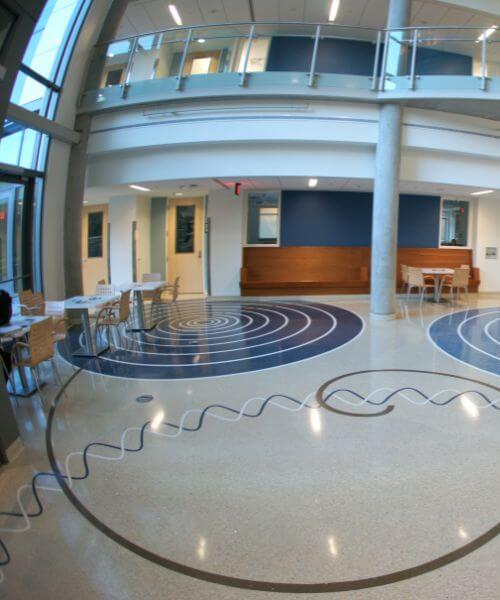
Thinset Terrazzo with TERRAZZCO Brand Products
Today over 90% of terrazzo that is installed is thinset terrazzo. Epoxy terrazzo is installed in indoor environments, especially in high-traffic areas of buildings. There are many reasons why thinset terrazzo is the preferred choice today. At 3/8″ thickness, epoxy terrazzo is thinner and lighter than traditional terrazzo but generally stronger and more flexible to work with. It’s great for multi-story use. In addition to its durability, thinset terrazzo offers more versatility in colors and design, making floors truly unique in style. Projects benefit from its quick installation as well. Epoxy terrazzo can be installed one day, and cured the next with large areas covered in a single day. Terrazzo is regarded as a forever floor. Once installed, the floors can last the lifetime of a building with proper maintenance and care. As a result, architects and construction professionals are becoming more aware of the cost-effectiveness of thinset terrazzo long-term when compared to other flooring materials.
Concord Terrazzo Company is a single-source supplier of terrazzo materials. We’ll educate you on the thinset epoxy terrazzo system, and which TERRAZZCO Brand Products are used during the installation process.
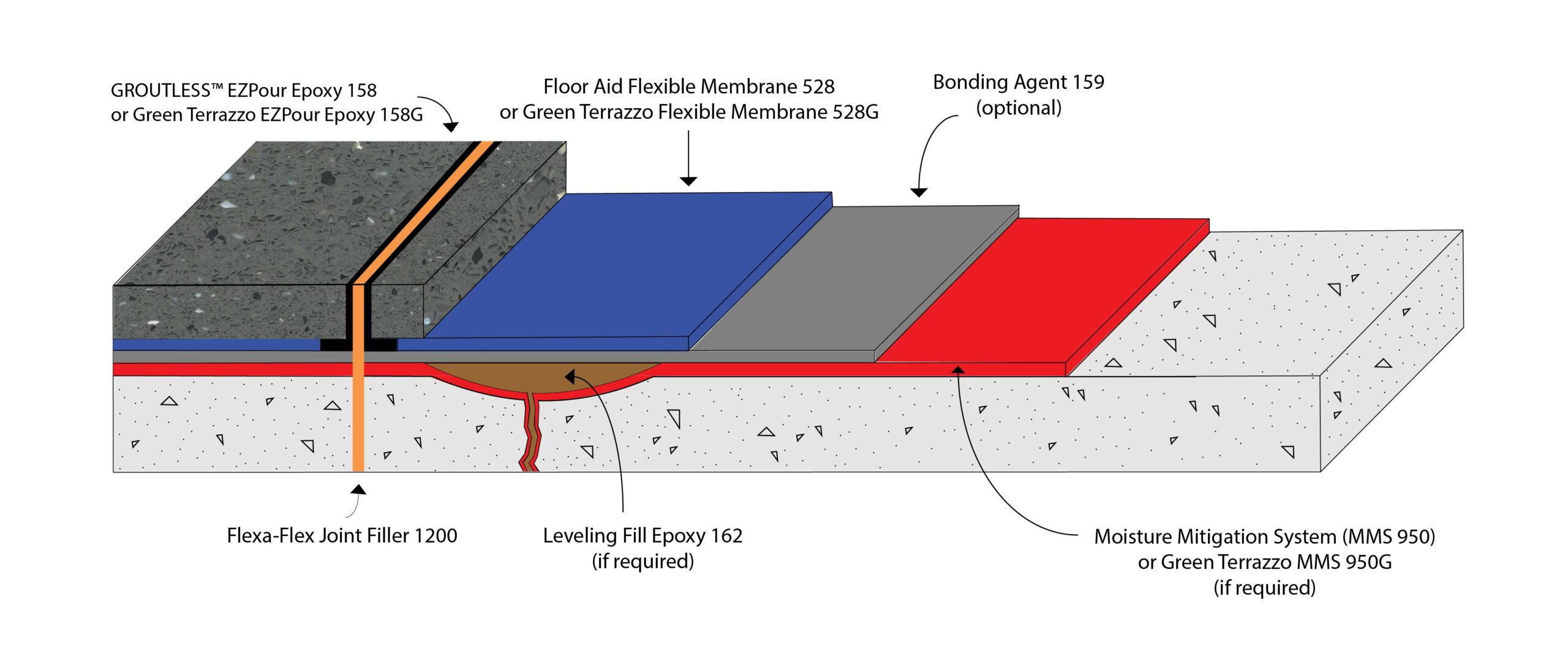
Components of a Terrazzo Floor
The above diagram shows an epoxy terrazzo system that uses TERRAZZCO Brand Products.
The substrate, surface preparation products, poured-in-place terrazzo, and sealer are key aspects of a terrazzo floor installation. Not all products are necessary when completing a terrazzo installation. This is dependent on the project conditions, which determines which products are required. For example, if a floor is not leveled, TERRAZZCO Leveling Fill would be an recommended solution to create an even uniform surface. The same applies to Moisture Mitigation System 950. If moisture levels exceed 75% relative humidity, then the product is recommended for use on terrazzo projects.
Substrate
Thinset terrazzo can be applied over a number of different substrates. For most projects, terrazzo will be poured over a concrete substrate, which is preferred for commercial construction buildings. Other substrates that epoxy terrazzo can be poured over include plywood, metal, existing flooring systems, and even older terrazzo floors. Just make sure that the underlying substrate is structurally sound and strong. Soft materials like carpet, vinyl, or loose tile shouldn’t be considered as an appropriate underlying substrate for epoxy terrazzo.
One of the first steps completed by terrazzo installers is shotblasting. Shotblasting refers to removing the top layer of concrete to remove debris and any irregularities. This helps to create a strong bond between the concrete substrate and terrazzo.
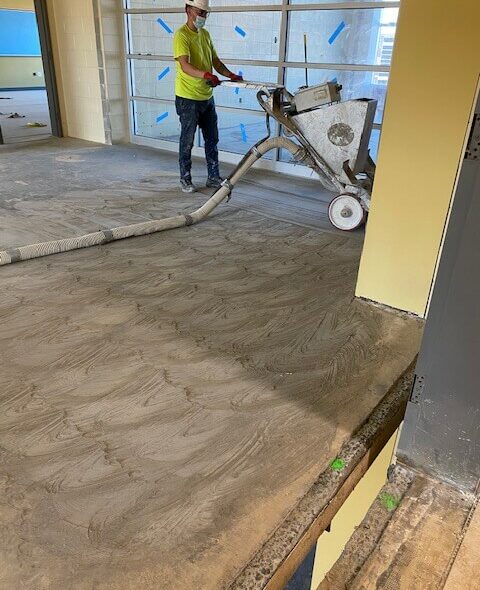
Surface Preparation
Before thinset terrazzo can be poured in place, installers will review the floor’s condition. This includes testing moisture levels in the substrate, checking for cracks, and observing the leveling of the surface.
Moisture Testing
Moisture testing is done to ensure that the concrete is dry and acceptable before pouring terrazzo. Relative humidity levels are tested using Wagner Meters ASTM 2170, which places in situ probes into the concrete to collect readings. What happens if the relative humidity is high? If relative humidity exceeds 75%-95%, a moisture mitigation system is an excellent solution to keep projects on track.
TERRAZZCO Moisture Mitigation 950 and TERRAZZCO Moisture Mitigation 950G are two products from Concord Terrazzo Company that can be used to protect the terrazzo from moisture vapor transmissions. TERRAZZCO Moisture Mitigation 950G is part of the Green Terrazzo system, which is made from renewable ingredients that are not Red Listed. This is ideal for sustainable building projects.
Why is a Moisture Mitigation System necessary? If the relative humidity is high, without a moisture mitigation system in place, it can cause flooring issues. These issues include a weak bond between the concrete and terrazzo, blisters and delamination.
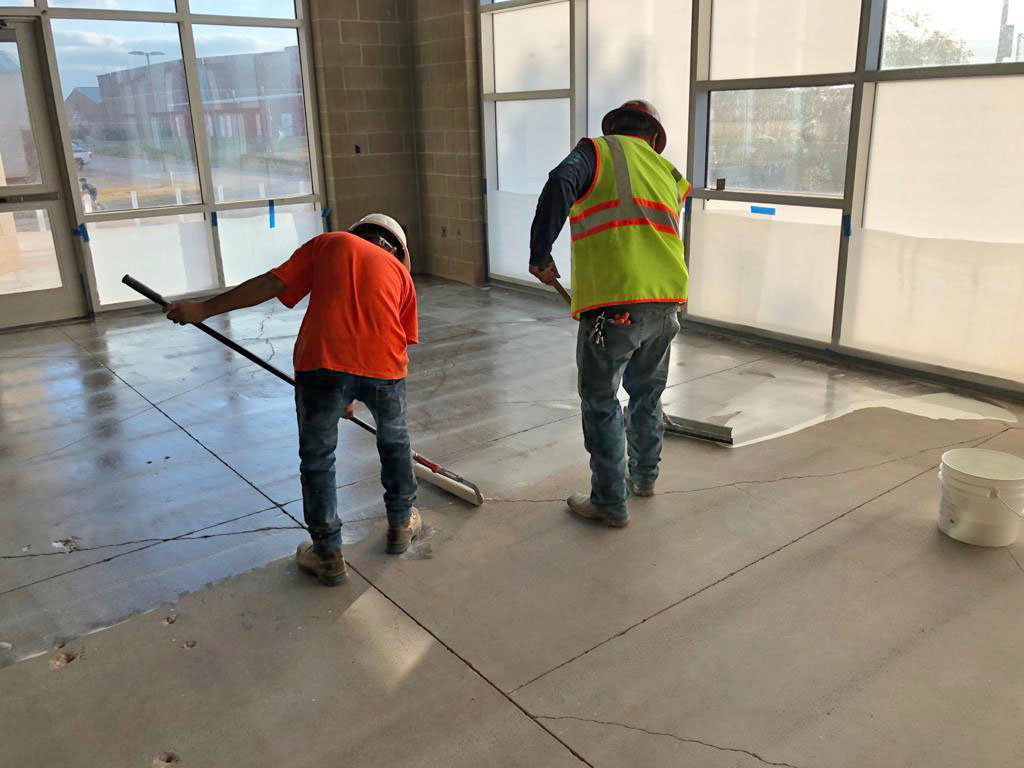
Leveling Fill Epoxy
Leveling Fill is used in situations where the floor level is uneven. The epoxy resin is mixed with aggregates and applied to a desired thickness resulting in a even and uniform surface.
TERRAZZCO Leveling Fill Epoxy 162 is an optional product for terrazzo installations. Its only needed when floor levels are out of tolerance.
TERRAZZCO Leveling Fill Epoxy 162 may be required to fill any cracks or voids.
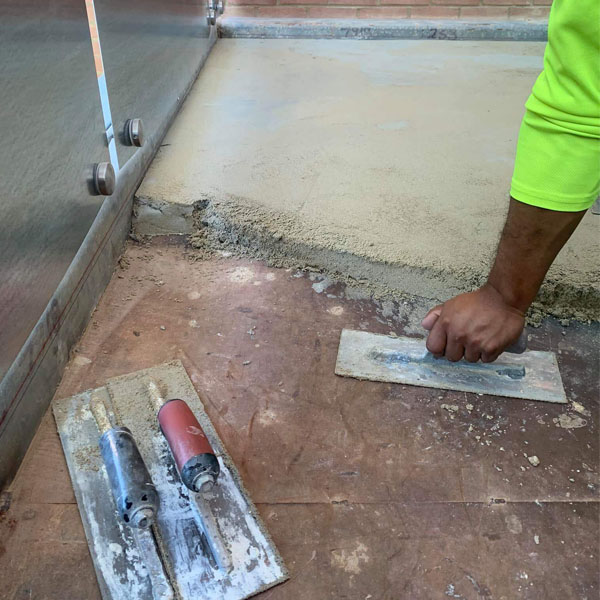
Floor Aid Flexible Membrane
Installers will check for cracks in the substrate. Flexible Membranes (Crack Suppression Membranes) are used to prevent substrate cracks from transferring to the terrazzo topping.
Concord Terrazzo Company manufactures Floor Aid Flexible Membrane 528, and its Green Terrazzo version Floor Aid Flexible Membrane 528G. Floor Aid Flexible Membrane 528 should be used to treat all cracks, control joints & cold pour joints in the substrate. Rigid epoxy is used to fill in the cracks.
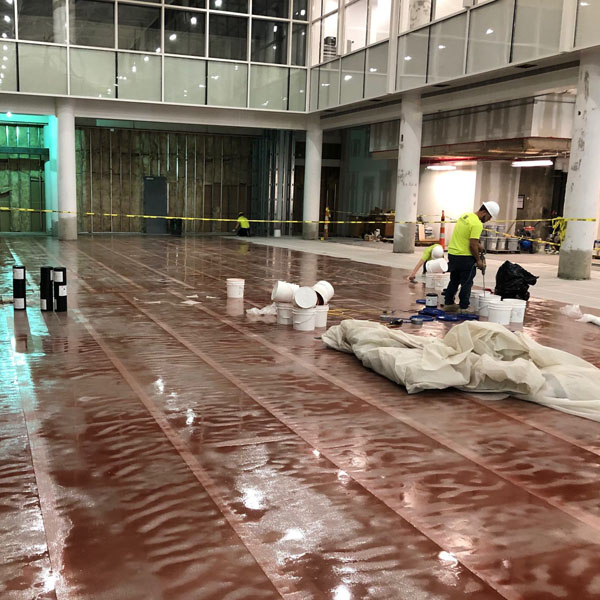
Design Layout
Thinset Terrazzo allows flexibility to create any floor imaginable. Architects and designers can design classic designs or elaborate patterns.
After the surface preparation is complete, installers can place divider strips. Divider strips serve two main purposes: to transition color changes and to control cracking of the terrazzo surface.
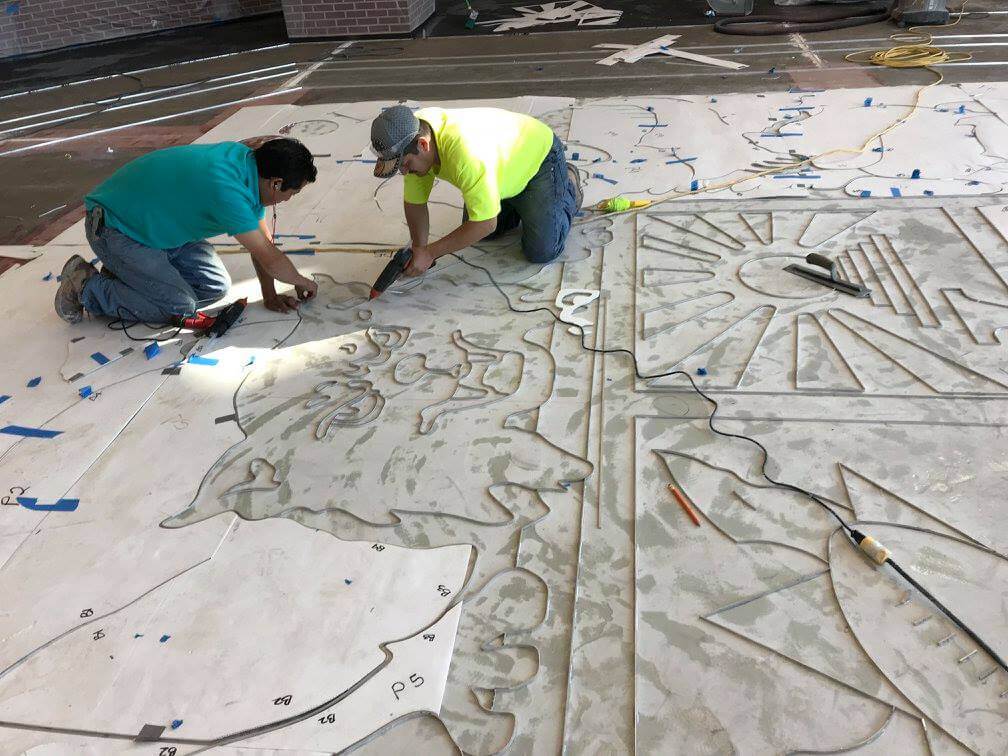
Poured in Place Terrazzo
Thinset terrazzo is ready to be poured once the design layout is complete.
As a single source supplier in terrazzo, Concord Terrazzo Company offers the epoxy matrix and aggregates for terrazzo contractors to mix on the job site.
TERRAZZCO® Groutless® EZPour Epoxy 158 and TERRAZZCO® Groutless® EZPour Epoxy 158G is a two-part epoxy resin that is mixed with aggregates then troweled at 3/8″ thickness. Aggregates range from marble, glass, shells, granite and synthetic chips. Together the epoxy resin and aggregates yield a durable and decorative flooring system that is ideal for commercial and institutional buildings.
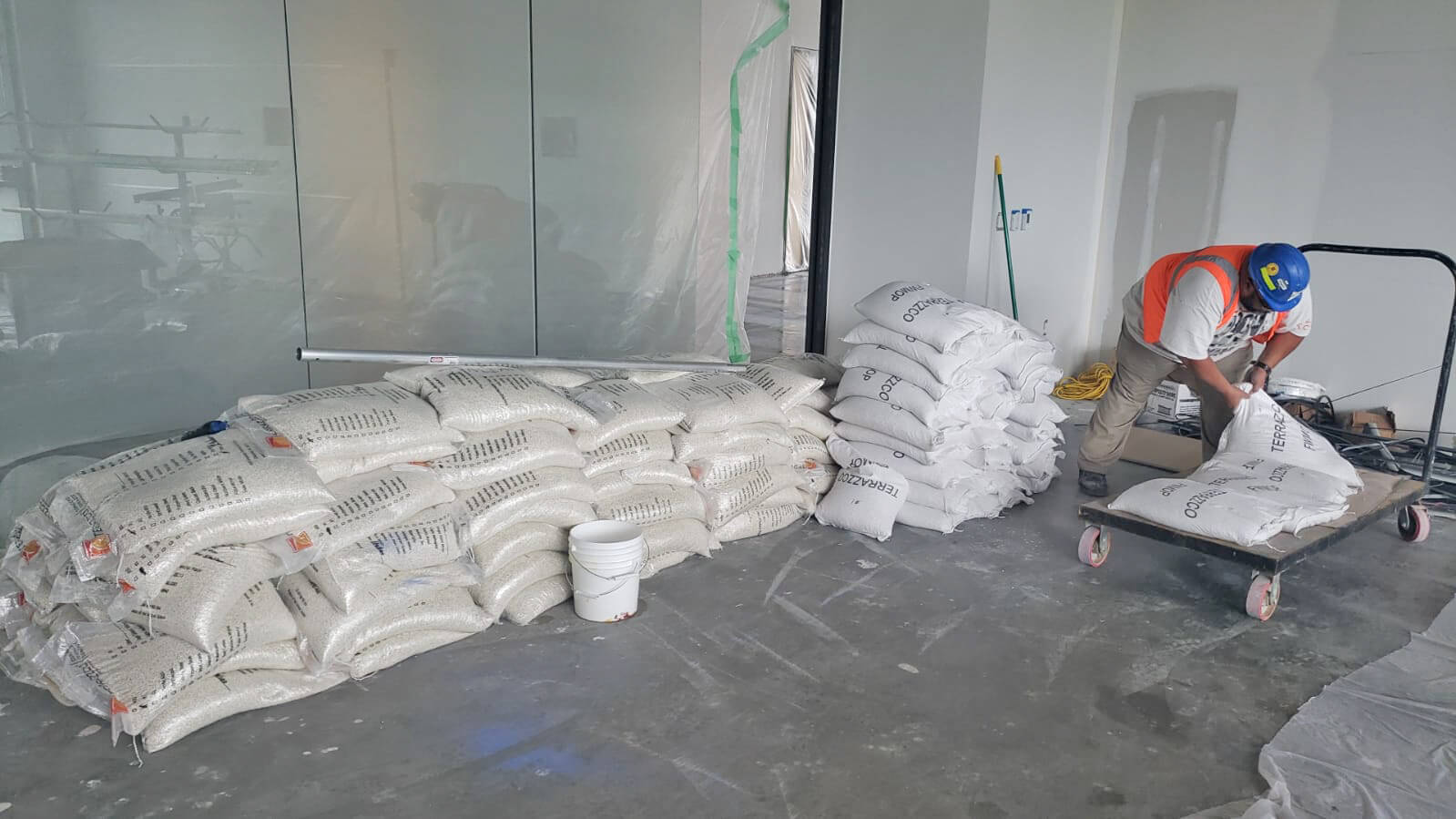
Mixing Ratios
When working with epoxy terrazzo, installers will use a 5:1 ratio of epoxy resin to hardener. A minimum of 180 of aggregates is added to the mix.
The aggregates and two-part epoxy resin are mixed thoroughly before it is poured in place.
Applying Thinset Terrazzo and Cure Rate
Once the two-part epoxy resin and aggregates are mixed thoroughly, the batch is taken to the designated area where the installer will begin pouring the terrazzo in place. Cast in place is another name for this process. In this step, the installer will pour the terrazzo at 3/8″ thickness within the divider strips. Typically one color is poured at at time.
One of the advantages of epoxy terrazzo is its speed of installation. An installer can pour terrazzo, and it can cure within a day and ready to be grind the following day.
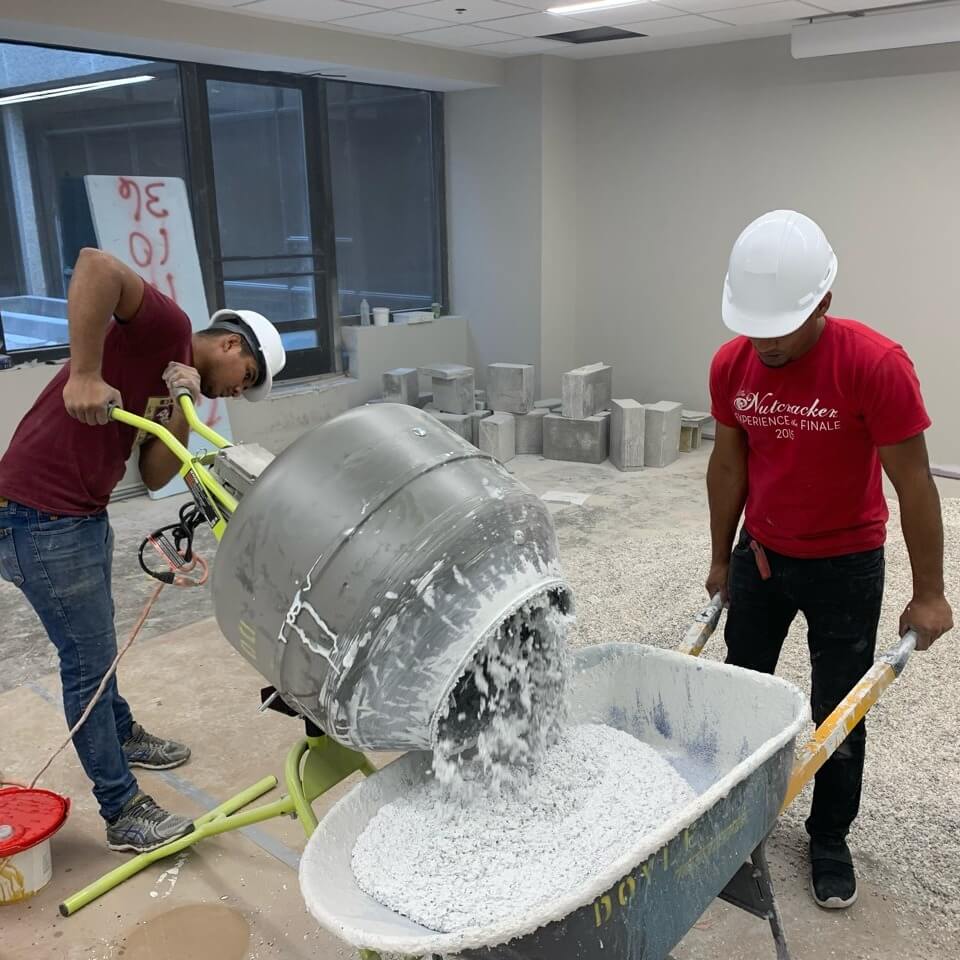
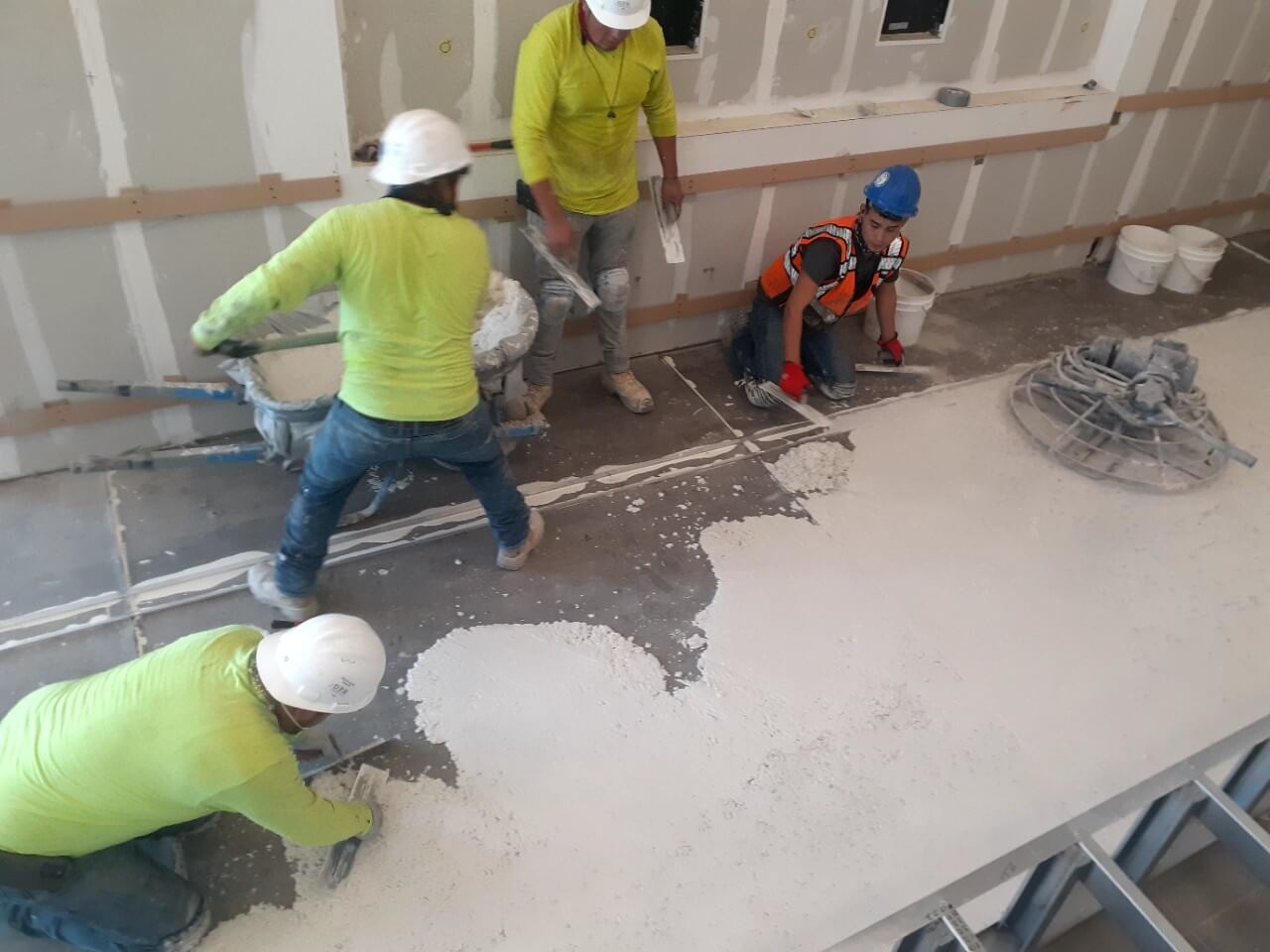
Grinding, Grouting, and Polishing
Once the terrazzo has cured, installers will begin the grinding and polishing process. This is the time when the terrazzo floors start to come to life as the color of the floor and aggregates start to appear.
Grinding transitions the thinset terrazzo from a rough to smooth surface. Grinding has multiple stages that go from rough, medium and fine grind.
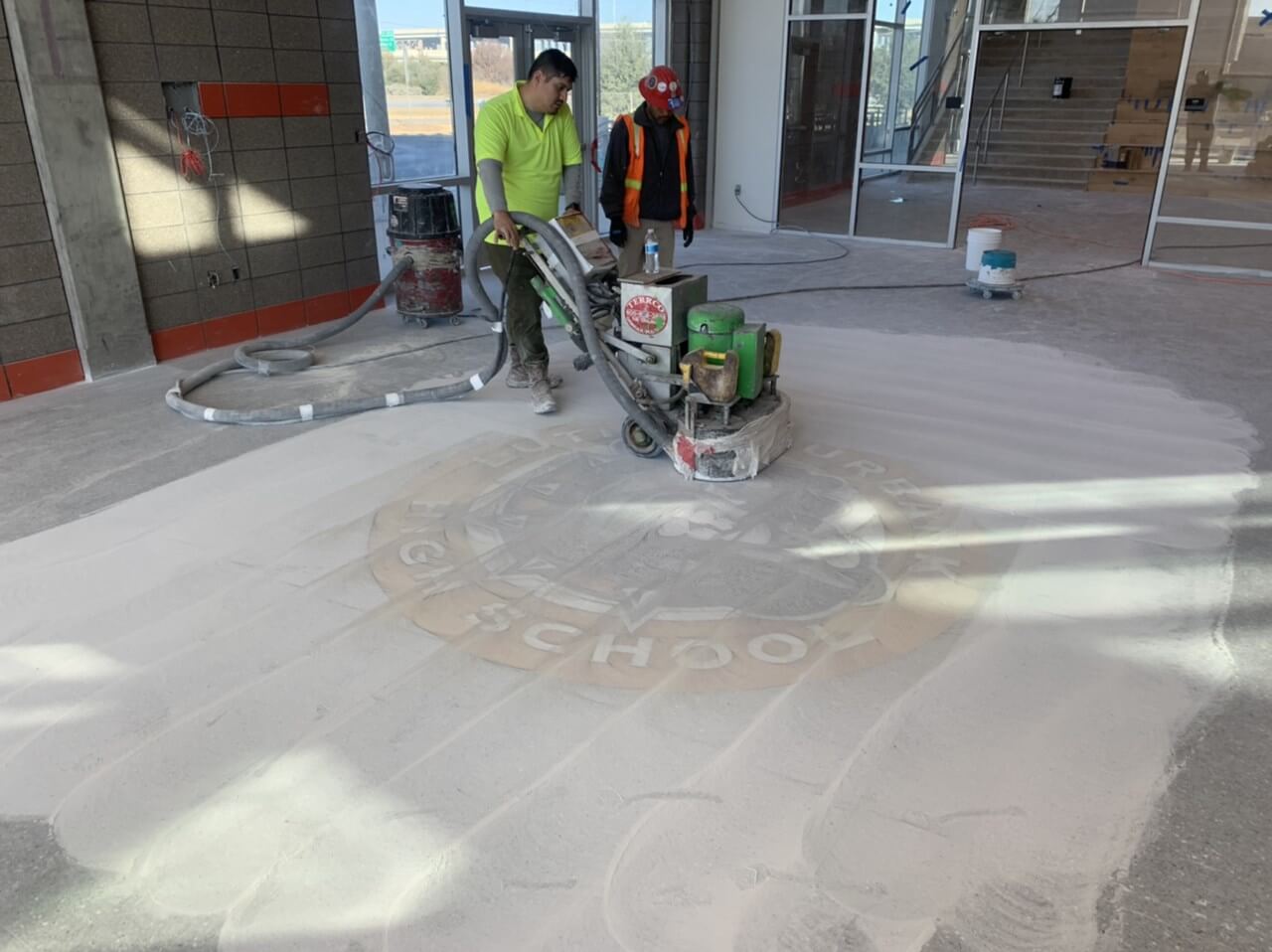
Grouting occurs next. This process involves taking a bit of epoxy and filling in any voids and pinholes left after the grinding stage. Groutless® EZPour Epoxy 158 is beneficial for installers as it reduces the amount of pinholes after the grinding process. In fact, in over 50% of installations that have used Groutless® EZpour Epoxy 158, installers did not have to grout the floor.
The polishing stage reaches the near conclusion of the terrazzo installation. As grinding is performed dry, polishing is performed wet. You’ll witness the nice shine once the polishing stage is completed.
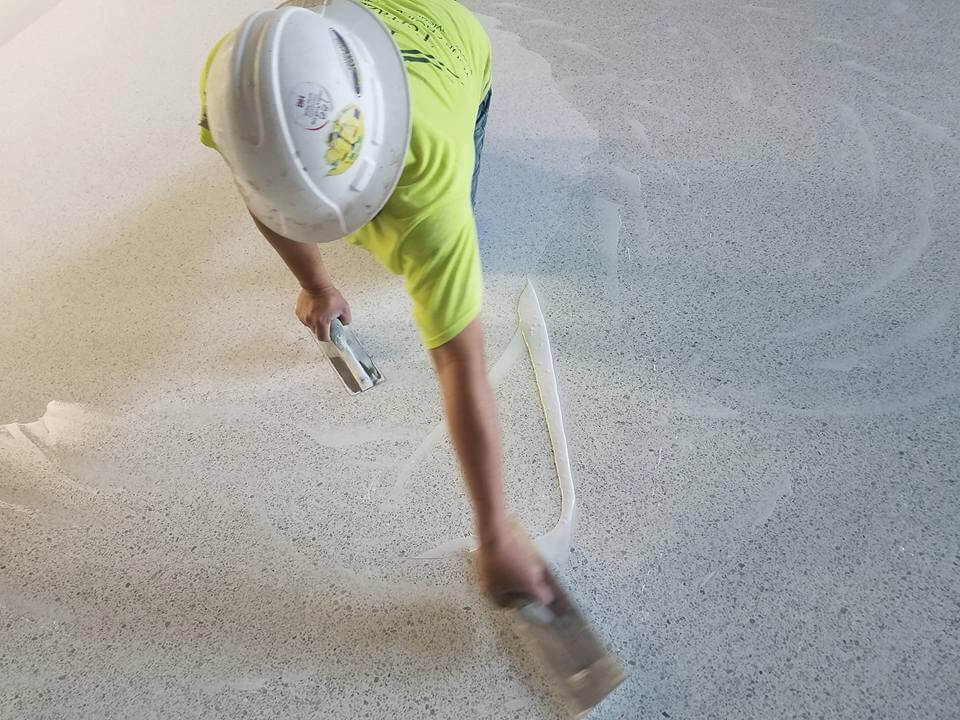
Sealer Application
After the polishing stage, sealer is applied. The floor is cleaned and dried beforehand. Two coats of a water-based sealer is recommended by the NTMA to apply over the terrazzo topping. Sealers provide protection for the aggregates and the terrazzo from dirt, debris, stains and moisture intrusions. Sealers also enhance the aesthetics of the thinset terrazzo floor.
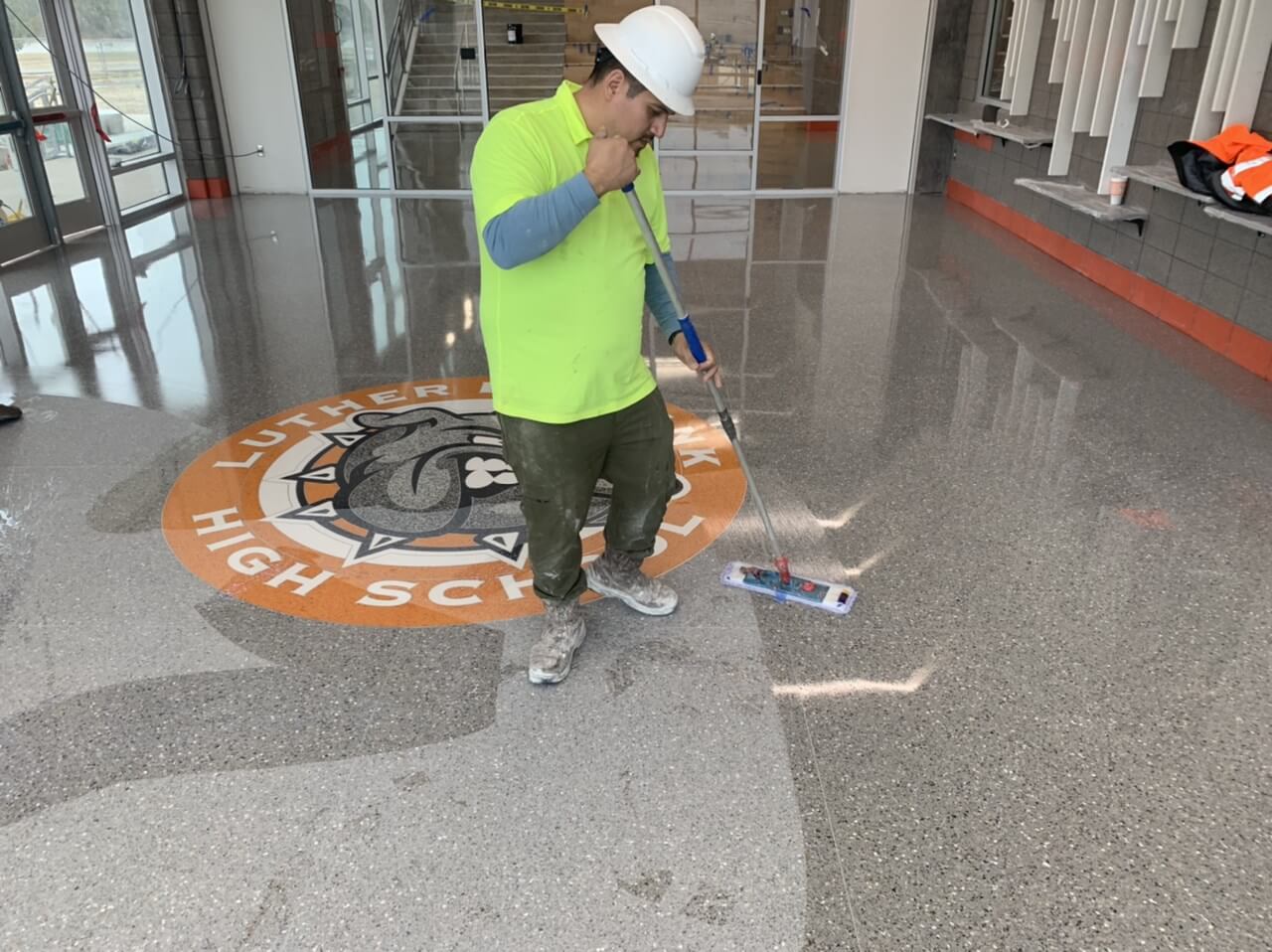
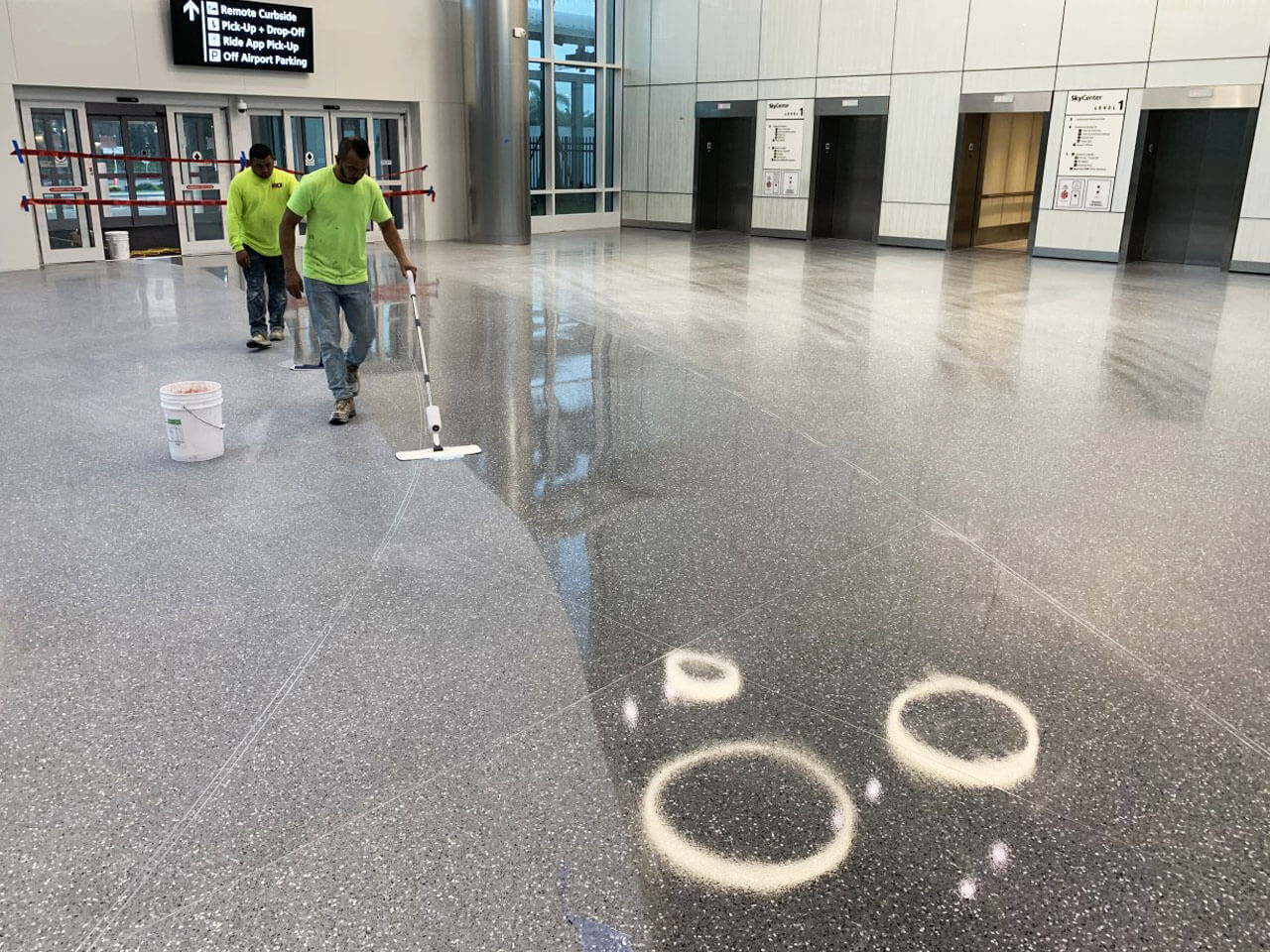
Advantages of Using TERRAZZCO Brand Products
Concord Terrazzo Company is the manufacturer of TERRAZZCO Brand Products. Located in North Carolina, Concord Terrazzo Company is a single-source terrazzo supplier. There are many products and services to choose from including:
- Epoxy resin products for a complete terrazzo system
- Green Terrazzo epoxy terrazzo products for healthier terrazzo flooring
- Wide range of aggregates in many different colors and sizes
- Waterjet capabilities to craft detailed logos and artwork for thinset terrazzo
- Custom sample development to plan terrazzo in the early stages of your project
- Precast terrazzo fabrication to complement terrazzo floors. Includes stair treads, countertops, and wall base.
When crafting a thinset terrazzo floor with TERRAZZCO Brand Products, it provides solutions for commercial and institutional projects.
- High compressive strength and durability
- Low maintenance flooring
- Low lifecycle costs
- Highly customized designs
- Zero VOCs for healthier indoor environments
- Built-in mold and mildew resistance
- Chemical and stain resistance
- Materials contributes to LEED points
For more information about TERRAZZCO Brand Products, contact a Concord Terrazzo representative by filling out our contact form: Get more details!



